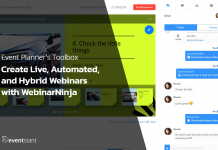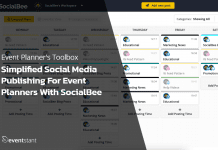
Hi, class! Today we're going to cover one of the most universally innovative movements in all of business and technology and how it specifically relates to trade show marketing. Social Media, a form of integrated marketing communications, is a group of Internet-based applications that allow the creation and exchange of user-generated content. Although widely perceived as an extremely economical method of marketing, in order to be successful and effective investment should be made in content as well as on an in-house or out-sourced expert on the intricacies of this phenomenon.
Trade show exhibitors are increasingly learning to take advantage of Social Media sites like Twitter, YouTube, LinkedIn, Facebook, Google+ and more to locate, identify and communicate with clients, vendors and prospects; this is also known as building communities (a.k.a. networks of contacts).
Whether tweeting a raffle prize drawing from one’s booth, posting the winner’s photo on Facebook or even uploading a satisfied client trade show interview on YouTube, there are several essential factors to keep in mind while acclimating to the subculture of Social Media and trade shows.
Fans and Followers
In order for exhibitors to use Social Media to their advantage, it is paramount to have a “following,” also known as a “community.” Without an expansive roster of interested or at least potentially interested parties, Social Media efforts will be futile as well as a waste of productivity. And we all know, class, “time is money.”
Hire or train a qualified and progressive candidate who is creative, has extensive computer & Internet experience, as well as strong marketing intuition. Building a Social Media “following” is a function of joining the appropriate media sites, both mainstream and niche, and then simply reaching out and exchanging information just as one would do at a physical networking event. For instance, on Facebook you would first build a comprehensive page or business “profile” with all pertinent details including contact and bio information, photos, promotions and schedule of events before “socializing.”
Think of it as if you were to attend an industry networking event: You would be armed with business cards, brochures and the like as well as being dressed professionally and appropriately. Same concept! Don’t reach out without preparation and presentation.
Now you are ready to “circulate.”
Reaching out and connecting with those closest to your industry and its peripheral is how the social media unfolds.
Each site is different. LinkedIn are individual professional profiles where you join groups and can invite others to join whereas Facebook allows you to create a business page that groups and individuals can “Like” (or “Friend”) resulting in their automatic receipt of your postings. Reaching out and connecting with those closest to your industry and its peripheral is how the social media unfolds. Suddenly an entire and colossal world of contacts will open through “suggestions” and mere exposure through existing ones.
Each site has different protocols, etiquette and objectives to which need to be adhered in order to maintain legitimacy, credibility, and “follow-ability.” Be sure your Social Media pro knows the “laws” of compliance and the intricacies of each available site. Being “flagged” can be embarrassing and result in ineligibility of site membership!
Timing is Everything
Keeping posts and links relevant and current is critical to Social Media marketing success. An exhibitor should announce its participation at a trade show approximately six months in advance following up with periodic reminders and more importantly, promotions and other-show related “news” before, during and after the exhibition. Take advantage of the opportunity to publicize contests, presentations and demonstration schedules as well as giveaways and when it’s all over — show success!
The key is to spread out the information in a timely and strategic manner in order to keep interest peaked. Redundancies and over saturation of information can cost you valuable exposure as “Followers” tend to “breeze” or “skim” past by that which appears to be “old” or “repetitive” news or information. Posts or links should have strong headlines or openers, brief yet concise information and art (graphics or photos) is always helpful in any form of media. There is nothing wrong, in fact, it is recommended to “Share” with your community or specific “members” when there are links and information of interest relating to not only your company but the industry (and your “friends’” industries) at large.
Thinking of and helping others in your community is always important whether in the real world or cyber space!
It's All About the Exchange
Social Media sites can be curious in the sense that no one really knows who and what is going on at the other end. It can be insulting when one only posts and does not share, comment or most of all, neglects to reply when a “Friend” or “Follower” reaches out. Intermittent Social Media participation does an exhibitor a true injustice. To succeed, it is vital to be consistent. The cultivating and nurturing of these relationships — while most predominantly “social” in nature — can someday turn into a deal, a referral or
opportunity of a lifetime!
Blog About It
Blogging is another form of Social Media that involves a website or part of a website maintained by an individual, writing commentary in the first-person, who has a following due to their expertise or occult appeal to a specific market. An exhibiting company fortunate to have a well-received in-house “blogger” should take advantage of the medium to update followers with details about current shows and related information thereof. Again, commenting on as well as sharing and “posting” others’ blogs is a way of paying it forward.
Homework
- Hire a Social Media expert (whether in-house or outsourced)
- Generate current & relevant content
- Be consistent through posts, replies and “shares”
- Watch your business grow!









![How Important Are Face to Face Meetings [INFOGRAPHIC]](https://eventstant.com/wp-content/uploads/faceToface_v11-sm-218x150.jpg)













